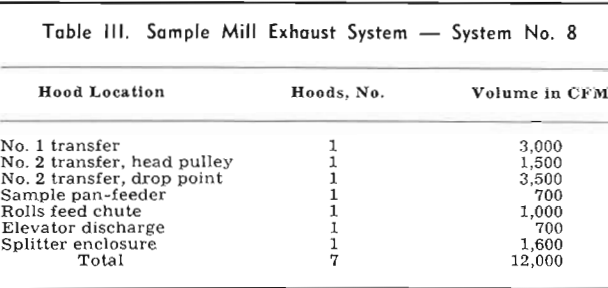Table of Contents
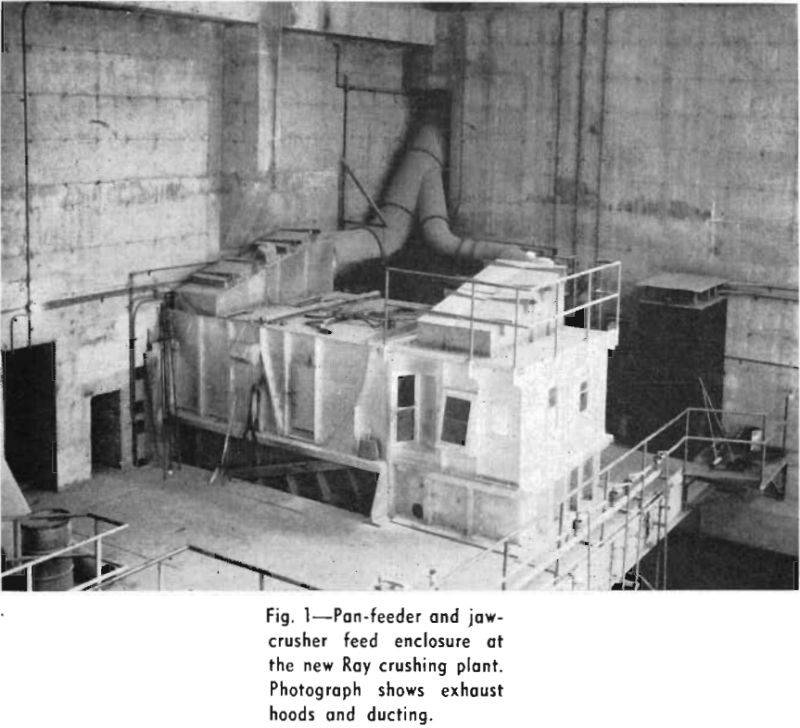
In 1947 an Industrial Hygiene Department was organized to represent and assist the four western mining divisions in industrial hygiene problems. Department headquarters are located at the Utah Copper Division, Magna Plant, Magna, Utah, with a branch office at the Chino Mines Division, Hurley, N. M. The headquarters staff includes a director, a department secretary, an industrial hygienist, a supervising ventilation engineer, and two ventilation designers. To be in closer association with work at the Southwest properties, a field engineer at the branch office conducts field studies which include ventilation problems at the New Mexico and Arizona properties, i.e., the Chino and Ray mines divisions.
Preliminary to the design of exhaust ventilation for the Ray property, rafter dust samples collected from the old crushing plant were analyzed and sent to dust collector manufacturers, who determined the settling rate, the particle size, and the collector efficiency ratings.
The schist type of ores were found to be water repellent, and when finally wetted became very adhesive, sticking to the conveyor belts and idlers. The dribble problem that ensued was most difficult to cope with because of the number and length of the conveyors. Obviously this characteristic ruled out the possibility of using any form of water spray preliminary to and during crushing operations.
Exhaust System Design Characteristics
Estimating of air volumes to be exhausted from enclosures and housings continues to be more of an art than a science, although several engineers in the field have made some progress toward standardization. In a paper published in 1949 an attempt was made, using water droplets, to determine the extent of displaced air caused by material falling into a tank. The empirical formulas developed in this paper are not directly applicable for use in the field but were a start in the right direction, to be followed by a more practical plant operations approach.

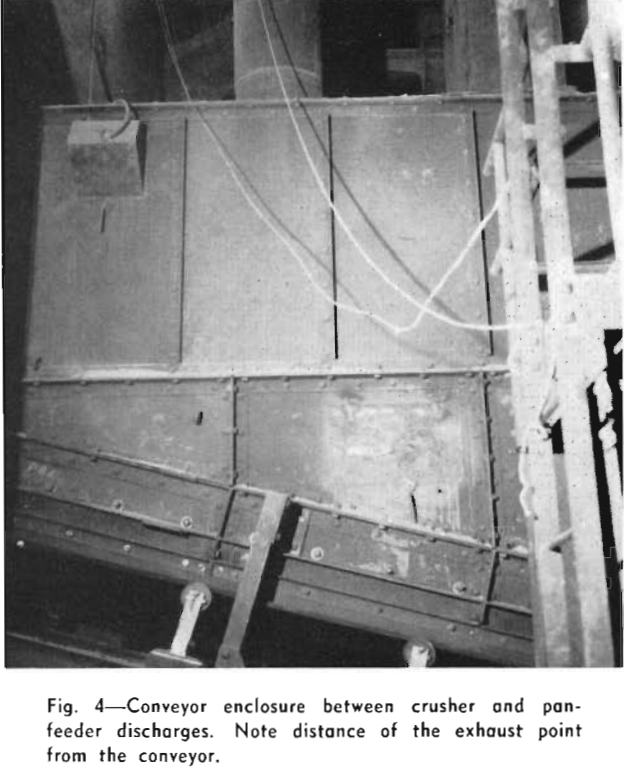
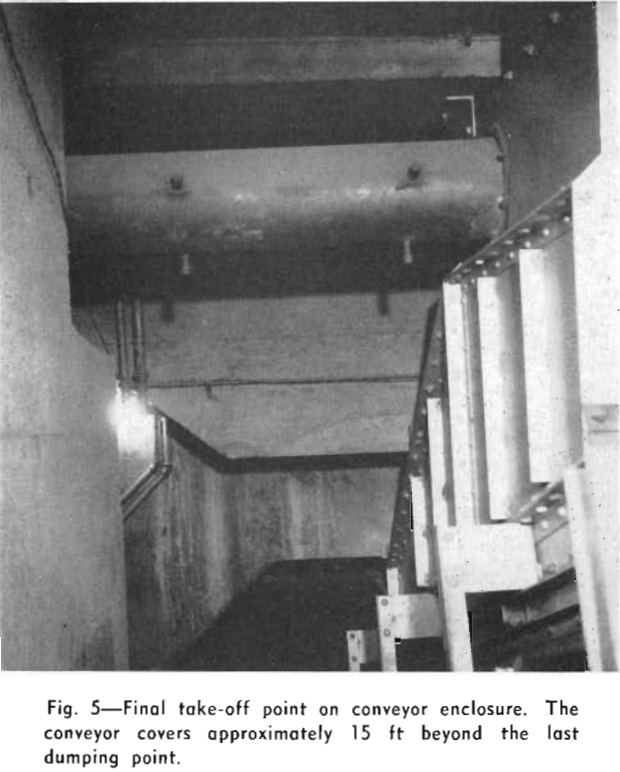
Air flow distribution in exhaust systems can be accomplished in one of two ways, by orifices or dampers or by properly adjusted pipe sizes. Although employment of the first method is widespread, there are disadvantages such as rapid wear due to restricted area, tampering by unauthorized personnel, and often the complete removal of dampers. In so far as continued successful operation is concerned, the use of regulated pipe sizes is the better of the two methods. On Ray installations this method was employed on all dust control systems with the exception of the sample mill exhaust system, where diversified control was advantageous.
Exhaust System Installations
Opinions vary among the authorities in the field of dust control regarding the size of exhaust systems. However, it is the policy of this department to keep the installations small for greater flexibility. The design of the Ray primary and secondary crushing-plants was so organized that the various crushing and screening processes were amenable to the smaller exhaust systems.
The ore from the open pit mine is transported to the crusher by 22-cu yd Euclid trucks. A two-gate horizontal slide portal admits the ore to the receiving hopper wherein grizzly bars separate the fines from the oversize product. The oversize material is carried by pan-feeder to the large jaw-crusher with the undersize, minus approximately 7-in. material passing to the undersize bin where it is fed to the No. 1 conveyor by a variable speed pan-feeder. Provisions were made for eventual exhaust from the receiving bin, if found necessary. However, secondary ventilation is provided by exhaust from the enclosure over the oversize pan-feeder and jaw-crusher and by ejector effect of fines passing through the grizzly section.
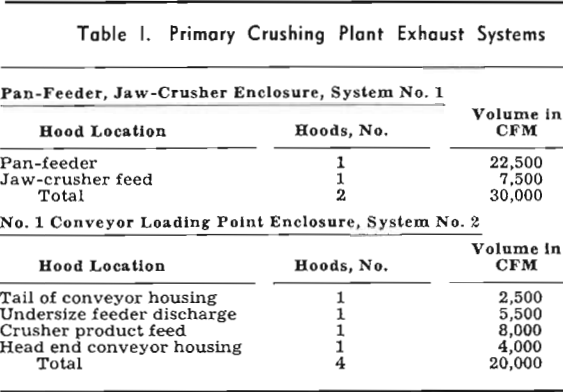
Secondary Crushing Plant
As shown in the flowsheet, there are four exhaust systems in operation in the secondary crushing plant, with additions planned for the system exhausting the underground ore-receiving bins. When the system is completed, a volume of 99,300 cfm will be exhausted from the crushing and screening operations in the secondary crushing plant.
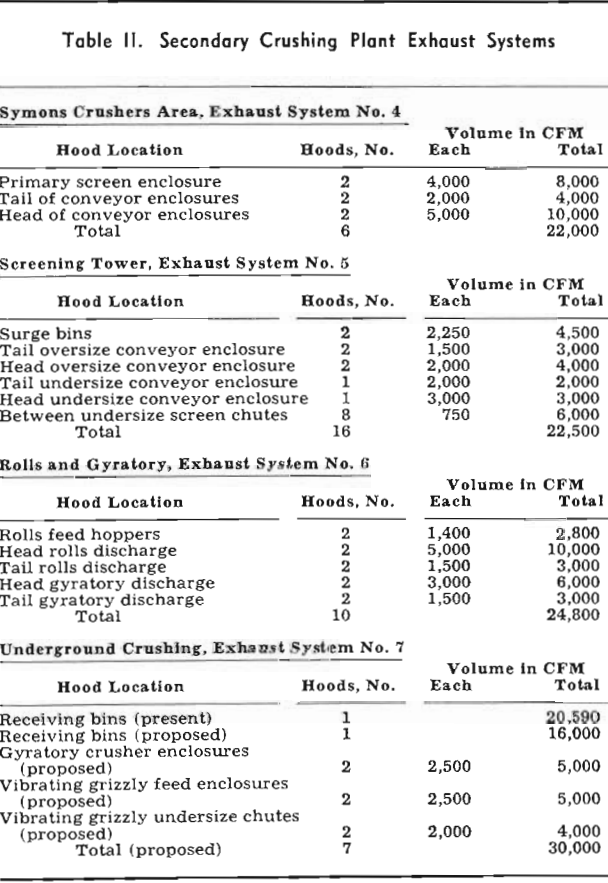
The major portion of the air is taken from tight-fitting housings over the conveyors receiving the screened and crushed product. Air is exhausted from the head and tail of each conveyor housing with exhaust hoods several feet from and well above feed points on the conveyors.
Secondary Screening Towers: The Symons crushers product and the undersize from the primary screens are conveyed to a 360-ton capacity surge bin, situated immediately above the secondary screening plant. The ore from the bin is choke fed to 10 screens. The undersize, screened to about 2 pct on ¾-mesh screens, is conveyed directly to the shipping bins.
Housekeeping
A central vacuum cleaning system has been ordered to facilitate clean-up work in the secondary crushing plant. The unit is designed to handle two—2-in. or four 1½-in. hoses continuously.
